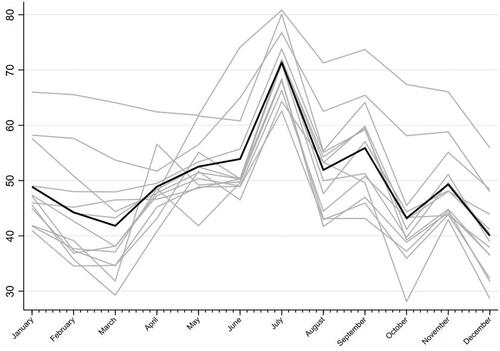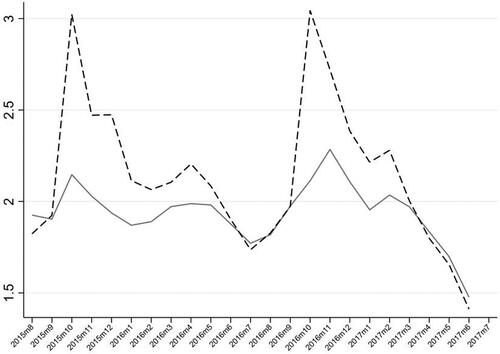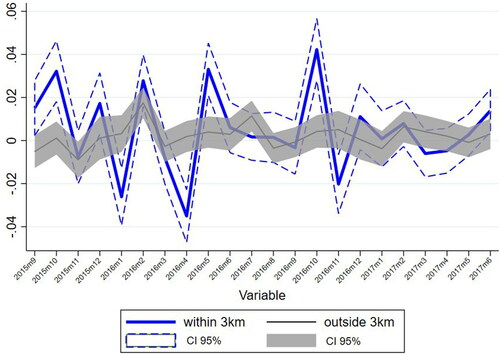Figures & data
Table 1. Sample characteristics.
Figure 1. Ratio of exit to available by months.
Note: Figure reports the exit ratio, calculated by dividing the number of listings exiting the market in a calendar month by the total number of existing listings in relevant calendar month regardless of year. Time span is the period from August 2015 to August 2017 period. Each Grey shaded line represents one of 13 cities included in the sample. The dark solid line represents the ratio for the whole sample. Figures for individual cities are presented in Online Appendix.

Figure 2. Average time on market (in months).
Note: represents time on market. Each point on the line provides the average length of marketing time of the listings that come to the market in relevant month. The dashed-black line represents the listings which are within 3-km distance to a university campus. The solid grey line represents the listings which are more than 3-km away from a university campus.

Figure 3. Price change over time.
Note: represents the coefficients from two-period rolling-time-dummy OLS regressions. The dependent variable in the regression is log-weekly rental price. Each regression includes 2 sequential months only to capture changes in prices after controlling for size and city. For instance, in the first regression, listings that come to market in August 2015 and September 2015 are included where a dummy for September 2015 listings is added as a regressor. Second regression excludes August 2015 listings, includes October 2015 listings and accordingly a dummy for October 2015 listings is included in the regression. Same procedure is repeated for each month of the sample period. All regressions include variables to control for number of bedrooms and city of listing. Thin black line represents the listings which are more than 3-km away from a university campus. Thick blue line represents listings which are within 3-km distance to a university campus.

Table 2. Regression results- 3-km sample vs full sample (Dependent Variable: Dummy variable indicating the exit from market).
Table 3. Regression results, interaction effects (Dependent Variable: Dummy variable indicating the exit from market).
Data statement
Our data were collected using Zoopla API service. Unfortunately, we cannot make our dataset public as the terms of use of the API (as of 2018) will be violated. Current terms (as of 2021) do not allow storing the data (https://developer.zoopla.co.uk/API_terms_of_use). A researcher who would like to replicate our study might consider applying for an alternative source of Zoopla data (e.g. through Urban Big Data Centre https://www.ubdc.ac.uk/). However, all Stata and Python codes available upon request from authors.
